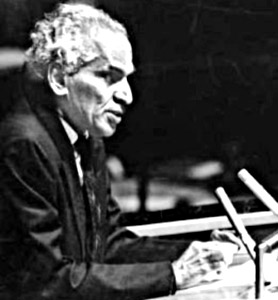 Indian Independence Act, 1947 contains the following provision regarding Indian States: All treaties, agreements, etc between His Majesty`s Government and the rulers of the Indian States shall lapse. The words `Emperor of India` shall be omitted from Royal Style and Titles. The Indian states will be free to accede to either of the new Dominion of India or Pakistan. Monarchy was abolished and hence, the princely states were to be annexed. In the National Provisional Government, Sardar Vallabhbhai Patel headed the State Department. Patel and his chief aide, VP Menon appealed to the sense of patriotism of the Indian princes and persuaded them to join the Indian union.
Indian Independence Act, 1947 contains the following provision regarding Indian States: All treaties, agreements, etc between His Majesty`s Government and the rulers of the Indian States shall lapse. The words `Emperor of India` shall be omitted from Royal Style and Titles. The Indian states will be free to accede to either of the new Dominion of India or Pakistan. Monarchy was abolished and hence, the princely states were to be annexed. In the National Provisional Government, Sardar Vallabhbhai Patel headed the State Department. Patel and his chief aide, VP Menon appealed to the sense of patriotism of the Indian princes and persuaded them to join the Indian union.
The annexations were to take place on the basis of surrender of three subjects of Defence, Foreign Affairs and Communication. Lord Mountbatten aided Patel in his mission too. As a result by 15th August, as many as 136 jurisdictional states acceded to the Indian union. Kashmir`s Maharaja Hari Singh signed the Instrument of Accession on 26th October, 1947 and the Nizam of Hyderabad in 1948.
V P Menon, on the other hand, successfully negotiated instruments of accession with a number of small states of Orissa with the Province of Orissa. On 18th December, the Chattisgarh rulers merged with the Central Provinces. Between the periods of 17th to 21st January 1948, Menon acquired the agreement for scores of minor states in Kathiawar to form the Union of Kathiawar, which began to govern on February 15. This set the pattern for the subsequent accession and merger of many tiny remaining states over the next five months.
For geographical and administrative reasons, Baroda and Kolhapur were annexed to the then Bomaby Province; Gujarat states were also merged with the Bombay Province. A second form of integration of 61 states was the formation of the seven centrally administered areas. Thus the states of Himachal Pradesh, Vindhya Pradesh (present day Madhya Pradesh), Tripura, Manipur, Bhopal, Kutch and Bilaspur were formed. Apart from these the states of United States of Matsya, Union of Vindhya Pradesh, Madhya Bharat, Patiala and East Punjab States Union, Rajasthan and United states of Cochin-Travancore were also integrated to the India.
However, the unification of India was still incomplete without the French and Portuguese enclaves. The French authorities were more realistic when they ceded Pondicherry (Puducherry) and Chandannagore to India on 1st November, 1954. However, the Portuguese Government maintained that since Goa was part of the metropolitan territories of Portugal, it could be in no way affected by the British and French withdrawal from India. When negotiations and persuasions did not move the Portuguese government, units of Indian army had to be mobilized and Goa, Daman and Diu were liberated and annexed to India on 19th December, 1961.
Thus, after much toil Sardar Vallabhbhai Patel and his aides successfully integrated the Indian states to form a unified country.



















